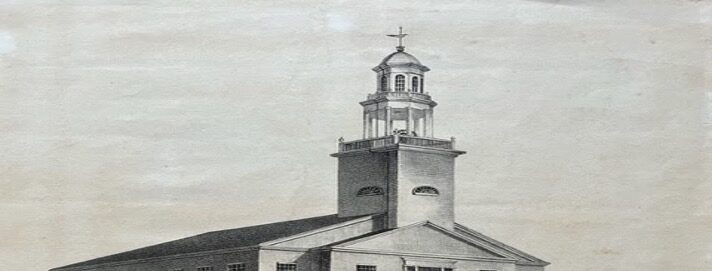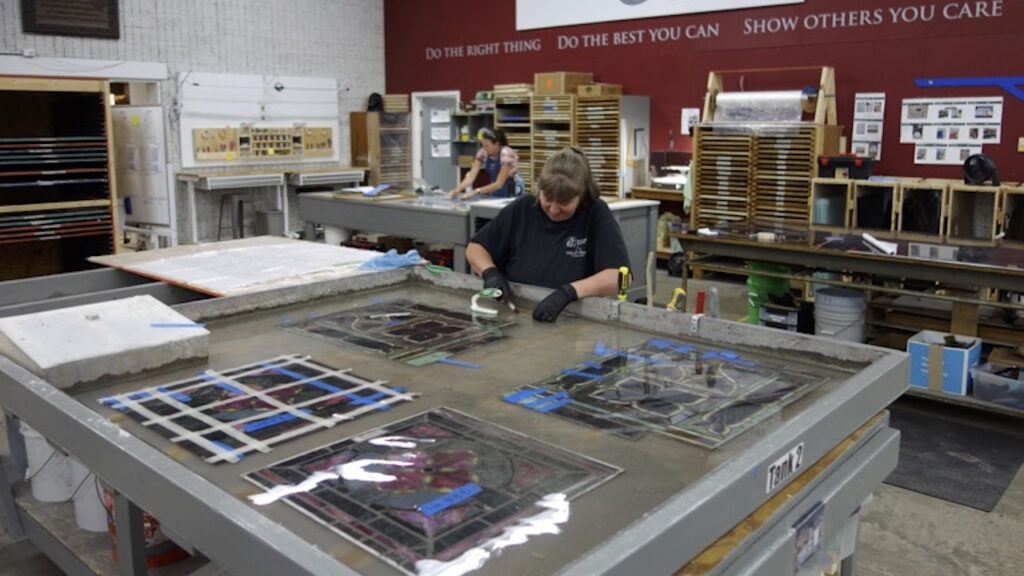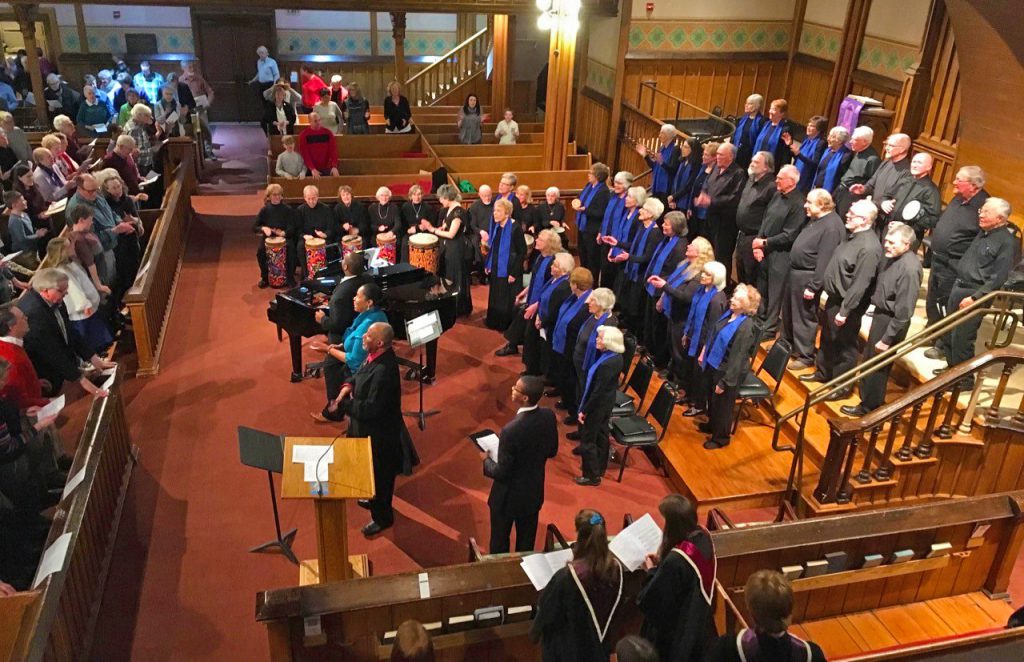By:
NEWS
From the Archives... The Ties That Bind - Chamberlain and First Parish Church

Born Lawrence Joshua Chamberlain on September 8, 1828, in Brewer, Maine, “our” famous General Chamberlain was influenced by our church and two other beloved places near our church that captured Joshua’s heart forever, Bowdoin College where he graduated in 1852 and his house which is now a museum that honors his life. Our focus for our July/August sanctuary display is about the important connections with First Parish Church that influenced Chamberlain in his life.
For the past six years, Ronald C. White, noted NY Times bestseller author of two previous books, A. Lincoln: A Biography and American Ulysses: A Life of Ulysses Grant, spent time in our church archives, at the Pejepscot History Center and in the Special Collections of the library at Bowdoin College in addition to other sources before writing his latest book released last winter, On Great Fields: The Life and Unlikely Heroism of Joshua Lawrence Chamberlain. The photo above is of Chamberlain as a student at Bowdoin College and is one of this article’s images courtesy of Joshua Chamberlain Papers, Bowdoin College Library. Although there is limited correspondence or written work from Joshua while a student at Bowdoin or as a member at our church, we are fortunate to have Rev. George Adams’ diaries that include his notes about Chamberlain and, of course, his daughter, Fanny.
Although any of us can learn a lot about Chamberlain at Pejepscot History Center, Bowdoin College or in many books about his heroics during the Civil War especially with the 20th Maine Regiment at Gettysburg during the Battle of Little Round Top, his involvement at First Parish Church and with his favorite professors who also attended and contributed significantly to First Parish Church had a strong role in shaping his faith and his character.
He and his four younger siblings spent their early years on a 100 acre family farm along the Penobscot River next to Brewer, Maine. He was named Lawrence Joshua Chamberlain for Commodore Lawrence of the American Navy. According to White, “Chamberlain recalled that his parents admired how the biblical Joshua ‘left nothing undone which the Lord had commanded.’ Lawrence’s early years with a strong Christian faith, a love of music, an adventuring spirit and a commitment to education came together to create the values that would shape his life.”
According to White, in Chamberlain’s family “church and Sunday School were strictly attended. If Lawrence missed either meeting, he knew he must make up for it by memorizing one of the Psalms, or a portion of the Beatitudes, or a hymn, and repeat it at mother’s knee before sunset Sunday evening.” In addition to studying his Bible regularly, Chamberlain also had a life-long passion for learning languages. With the Penobscot tribe living only a mile from the back of his family’s farm, as a young boy, Chamberlain’s curiosity and interest helped him learn some of their tribal language.
Chamberlain’s parents shared their hopes for his future. His father wanted Chamberlain to attend West Point and to have a career in the military while his Mother hoped that he would enter Bangor Theological Seminary, only a few miles from their home, and devote his life to the ministry or the missionary field. As the first born, you can imagine Chamberlain’s burden in choosing. After much consternation, Chamberlain decided to give teaching a try and was hired at age 16 to teach students from the ages of 4-24 in Wiscasset for 6-8 weeks in January and February. With great satisfaction from this experience, the following winter he taught at a school in Milford, Maine. As his 18th birthday approached in 1846 (the year that our present sanctuary was dedicated), he needed to make a career decision. What does one do sometimes when a decision seems too difficult? Yes, he decided to delay that decision and, instead, applied to Bowdoin College.
Of course, Bowdoin was all male at that time and admission was done after an extensive oral entrance examination including demonstration of Latin grammar, geography, arithmetic and algebra in addition to being well-versed in Greek and, of course, having a good moral character. To prepare for this extensive entrance examination, Chamberlain worked for nearly 17 hours each weekday either alone or with a tutor at his family home and, after over a year of preparation, finally departed early one morning in February of 1848. Chamberlain and his tutor traveled by sleigh over 100 miles from Brewer to Brunswick along the coast to avoid the huge snow drifts that might delay them even more and arrived for Chamberlain’s Bowdoin entrance examination in front of several professors. With success, early the next morning, Chamberlain reported to his first class.
Bowdoin required their students to attend religious services twice each day and there was also a weekly chapel service where President Woods spoke. Each Sunday morning, all Bowdoin students were required to attend First Parish Church. Rev. George E. Adams had arrived as the minister for First Parish in December 1829, so he was well established as a religious leader in Brunswick as well as throughout the state. From letters during this time period, Chamberlain seemed to embrace these religious services and also joined a Thursday evening Bible study and a Saturday evening Prayer Circle and, during Sunday afternoons, he often taught Sunday School in a yellow schoolhouse in the area.
In previous archive articles, you may have read about our memorial windows honoring significant First Parish members from the 1850’s who we still mention with great appreciation and awe. Many of these impressive individuals were influential in Chamberlain’s life especially as a student. Professor Alpheus Spring Packard taught ancient languages at Bowdoin College and also was a dedicated member and deacon at First Parish Church. Chamberlain took many classes from him and also became friends with his son, William Alfred Packard, so frequently, he was a guest in their home during his years at Bowdoin. The beautiful memorial window in the balcony of the North Transept was dedicated to A.S. Packard for all that he did for our church.
Professor William Smyth taught mathematics at Bowdoin and also Sunday School at First Parish. He and his family sat in pew #12 in the South Transept of our sanctuary, the area where Bowdoin faculty and students sat. Smyth was a strong anti-slavery advocate and his home was a station on the Underground Railroad. The stained-glass window in the balcony of the South Transept was installed in memory of Professor Smyth.
Chamberlain was particularly drawn to Thomas Cogswell Upham, professor of mental and moral philosophy, who shared with Smyth an abhorrence of slavery and worried about what the future held for an increasingly divided nation. His wife, Phoebe Upham, was a frequent nuisance according to Rev. Adams’ diary because she would stop by his study to talk about women being able to speak in church meetings or to make other suggestions to him regarding our church.
In June 1848, the train arrived in Brunswick providing an important link to Boston. According to White, the six hour train trip stood in contrast with the previous three day carriage trip. You can imagine how that changed life for many people. That fall Chamberlain finally discovered an inspiring helper in Professor Packard who encouraged Chamberlain to address his issue with stammering (stuttering). Drawing upon Packard’s motivation to attack his problem as the Spartan’s did by singing in a particular way to manage through difficult passages and also by remembering a deeply embedded phrase from growing up with his father to “Do it! That’s how!” Chamberlain worked hard and was successful in conquering this frustrating issue.
Following his sophomore year when an undiagnosed illness made his family fear for his life as he laid in bed throughout that summer, Chamberlain decided to recover slowly at home throughout that next school year and returned for his junior year in the Fall of 1850. That fall brought tremendous opportunities to Chamberlain. He became the choir director at First Parish Church and spent considerable time admiring the beautiful organist, three years his senior, who turned out to be Fanny Adams, the adopted daughter and cousin of Rev. George Adams. After her biological parents in Boston decided to give her to a younger, childless cousin in Maine, Rev. Adams and his wife, Sarah, welcomed four-year-old Frances Caroline, known as Fanny or Fannie, and months later also welcomed another adopted child, Anna, who was close in age to Fanny, but from different biological parents.

Although fiercely independent, Fanny suffered from some depression and an unusual eye problem that led to frequent and painful headaches. She played the organ at the church many Sundays and, after her mother suddenly died on February 27, 1850, she moved to Portland choosing to create art in a studio there. Although not as smitten by Chamberlain as he was to her, Fanny continued her independent life even choosing not to join First Parish Church when she did not feel that she could accept the Christian beliefs that were required for membership. Nonetheless, Chamberlain persisted to demonstrate his love for Fanny, and by that spring, when Chamberlain and Fanny were both in the Brewer area one weekend, she was able to meet Chamberlain’s parents.
Also during the fall of 1850, Professor Calvin Ellis Stowe (Bowdoin ‘24) arrived in Brunswick to join his wife, Harriet Beecher Stowe, who was pregnant with their seventh child. Professor Stowe taught Natural and Revealed Religion after teaching sacred literature for 17 years in Cincinnati at Lane Theological Seminary. To help us set the stage, the Stowe family had lived in Cincinnati where the Ohio River defined the line between free and slave states, so after the Fugitive Slave Act was enacted on the 18th of September as part of the Compromise of 1850, they were well aware of the struggles of people chasing their freedom into the northern states who needed assistance from others to ensure their safety.
It is fascinating to imagine Chamberlain studying at Bowdoin under Harriet Beecher Stowe’s husband, Professor Calvin Stowe, and worshiping with them and also the Upham, Packard, and Adams’ families during these formative years in his life.
On March 2, 1851, following Communion in First Parish Church, Harriet Beecher Stowe had her vision of Uncle Tom’s Cabin and began writing her famous book. Because Bowdoin students were required to attend Sunday services, we can presume that Chamberlain shared in the same Communion service. In the months that followed, Harriet invited a few friends and family to gather in their kitchen at 63 Federal Street on Saturday evenings to listen to her read what she had written that week and to discuss it. Chamberlain and Fanny were among the listeners on many occasions. Stowe’s story was published as a magazine series starting on June 5, 1851, and in April 1852, the book was published and widely distributed in our country and, later, abroad.
When Rev. Adams spent nine weeks in Chicago attending a conference during the summer of 1851, Fanny’s relationship with Chamberlain grew more serious in Brunswick. That December, Rev. Adams married Helen Root, only six months Fanny’s senior, whom he had met in Chicago. After missing his opportunity to see Fanny who had departed for her father’s wedding in Massachusetts minutes before, Chamberlain left a letter for Fanny that included “Be happy – even if to be happy is to forget me a little. May God be over you and in you and keep you till we meet again or above.” Unfortunately, Fanny, her sister, Anna, and her aunt, Deborah, who also lived with them, found living with their new stepmother to be challenging. Although
Chamberlain and Fanny’s relationship strengthened throughout that year, Fanny decided to move to NYC in April 1852 to study music with her stepmother Helen’s famous brother, Professor George Frederick Root. By December, with the help of Professor Root, Fanny took a position at a girls’ academy in Georgia to teach music so she could repay her father for his financial support during her music study in New York. Because of the distance, Chamberlain and Fanny could only communicate through letters.

Meanwhile, following Chamberlain’s graduation from Bowdoin on September 1, 1852, he enrolled in the Bangor Theological Seminary for their three year degree where he spent the next three years studying in hopes of becoming a pastor. Although, as the years passed, his plans upon graduation changed.
Bowdoin asked him to give a master’s oration at the 1855 Bowdoin Commencement at First Parish Church where Chamberlain would also be given a master of arts’ degree. Following this talk at Bowdoin and having finished his master’s degree in divinity at Bangor Seminary in 1855, Chamberlain turned down pastoral offers at First Parish in Belfast, Maine, and First Parish in Wolfeboro, New Hampshire and, instead, accepted a position at Bowdoin College as a “junior provisional instructor in logic and natural theology” for one term that paid him $50/month. He was also asked to tutor some of the freshmen in Greek, a language that he had spent additional time studying before entering Bowdoin.
So, what happened next? What about Fanny? Did they ever marry? Did Chamberlain ever continue with the ministry or missionary work? In August, we shall continue with the story.
Below are two of Rev. Adams’s diary entries relating to Chamberlain and/or Fanny. More are included in our archive display in the sanctuary.


Below is the summer bulletin for 1974:
(Click on images to see an enlarged version)
Thanks for reading and may you be blessed with a glorious July!






